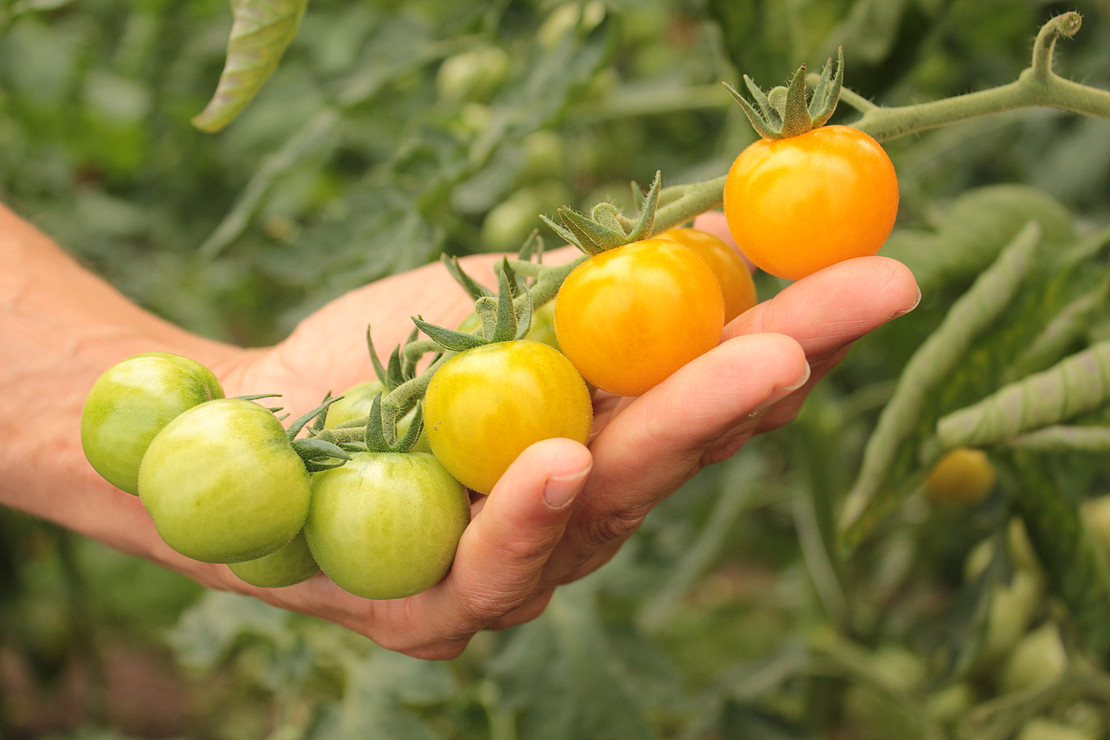This page contains automatically translated content.
Tomatoes from participatory breeding came through the wet summer better
 Image: Outdoor Tomato Project.
Image: Outdoor Tomato Project.In the Ecological Outdoor Tomato Project, scientists, professional gardeners and other participants breed new varieties without benefiting financially from so-called intellectual property rights. The project has produced nine new varieties since its nationwide launch in 2003. The varieties Primabella, Resibella, Rondobella, Vivagrande and, in the home garden, Sunviva have proved particularly resistant to late blight (a fungus with the scientific name Phytophtora infestans). The past wet summer was the acid test.
"The previous years, 2018 to 2020, were favorable for growing tomatoes outdoors in almost all areas of Germany: it was dry and hot, and infestation with P. infestans played little or no role," Horneburg reports. This year was and is different: "In many gardens, varieties with low or medium resistance were so severely damaged that yields remained low. Commercial cultivation in foil tunnels and unheated greenhouses was also severely damaged in some cases because the tomato plants remained damp for a long time at low temperatures and high humidity and became infested. Varieties bred in the outdoor tomato project, on the other hand, were able to extend the season and greatly increase yield."
Horneburg, an agronomist who researches and teaches at the University of Kassel's Department of Ecological Plant Breeding and Agricultural Biodiversity, attributes this to the broad breeding approach based on the tomato's diversity: "Participatory breeding in a wide variety of locations makes it possible to develop varieties that can handle highly variable climatic conditions." Annual meetings, known as Tomato Days, also ensured exchange between the participants; the most recent took place in September near Göttingen. At the Tomato Day, observations and data from exact trials are shared to breed the best varieties for very different soil and climate conditions. Instructions and scientific results are publicly available via the project homepage. Taste is considered through tastings at every step of the breeding process.
Phytophthora infestans is a harmful fungus that can adapt to its environment and break resistance. Says Horneburg, "One strength of the project is the network's 'sensor function': if varieties in one location lose resistance, a new solution is sought directly among the abundance of breeding lines."
The Organic Field Tomato Project wants to counter large seed corporations. Patents are also often applied for for tomato traits; if a new variety contains corresponding traits, license fees are due or use is prohibited altogether - an obstacle to the development of improved varieties. Patents for tomatoes are held by a few companies. In the field tomato project, on the other hand, breeders, growers, retailers, consultants and consumers jointly determine the goals and select the best breeding lines, Horneburg describes: "We exchange knowledge, plants and seeds in order to jointly search for new, promising varieties." The Sunviva and Vivagrande varieties are even protected as common property by the open-source seed license.
The project is not just about breeding for resistance: "the quality of home-grown tomatoes is unbeatable, and they contribute to a vibrant diversity of varieties," Horneburg affirms. In 2003 he founded the tomato project, and in 2020 he brought it to the University of Kassel. In some years, there are more than 30 locations across Germany.
The tomato is the most popular vegetable in Germany. We consume more than 28 kilograms per capita every year. More than 75 percent of the fresh produce comes from foreign greenhouses, processed tomatoes often even from overseas. Tomatoes grown organically outdoors consume 34 grams ofCO2 equivalents per kilogram of tomatoes, 99 grams are produced in conventional foil tunnels and up to 1,570 grams in heated greenhouses.
Additional photos (all: photo credit Organic Outdoor Tomato Project, unless otherwise noted): https://hessenbox.uni-kassel.de/dl/fiEYC2jWgv6xqBXFWQXxu9RR/PM%202021.zip
More voices:
Max Rehberg, tomato grower and producer in the humid North German Plain: "Many consumers still seem to have the prejudice that yellow tomatoes are rather bland and mealy. That this is not so is shown by the Sunviva and Dorada varieties from the organic field tomato project and many breeding lines."
Herwig Scholz, from the Scholz-Döbelin fruit farm, which is part of a solawi (solidarity farming) in the Lower Rhine region, says: "With the visible successes in open-air cultivation, we can achieve year-round supply. For this purpose, passata or whole fruits are preserved for the winter."
Moritz Halekotte of Culinaris - Seeds for Food, responsible for variety registration in the network: "The very diverse breeding program provides amateurs with cocktail, salad and meat tomato varieties for self-sufficiency even under more difficult conditions."
Contact:
Dr. Bernd Horneburg
University of Kassel
e-mail: bernd.horneburg[at]uni-kassel[dot]de
Participate: www.uni-kassel.de/go/freilandtomatenprojekt. In particular schools, the technical consultation of the allotment garden associations, as well as enterprises, which sell seedlings, can still participate.
Supply possibilities for seeds www.culinaris-saatgut.de. For young plants you ask with your offerer.
Press contact:
Sebastian Mense
Press speaker
E-Mail: presse[at]uni-kassel[dot]de